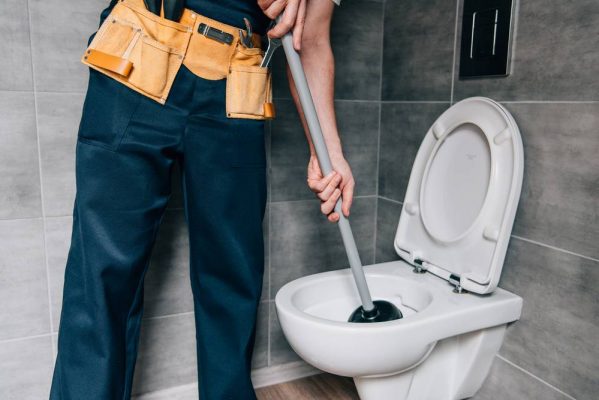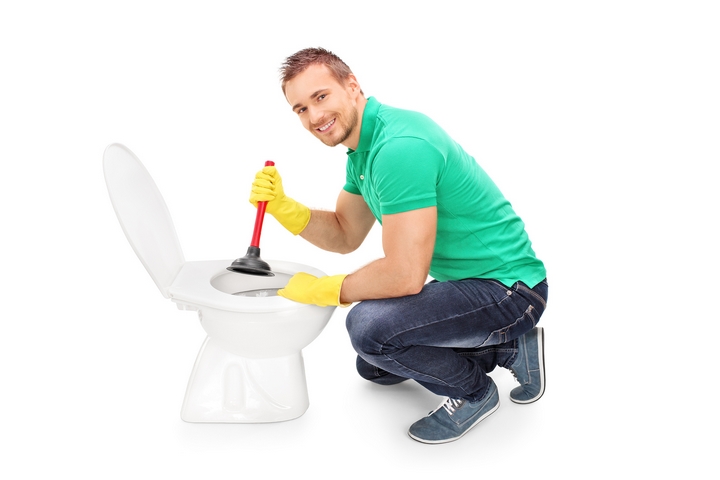Ways to Use Plunger and Drain Cleaners Properly: Pro Guidance
Ways to Use Plunger and Drain Cleaners Properly: Pro Guidance
Blog Article
Do you find yourself trying to locate content concerning How to Use a Plunger to Unclog a Toilet or Drain?

Introduction
Proper upkeep of house drains pipes is essential for avoiding blockages and ensuring smooth water flow. Among the secret devices in every home owner's toolkit is the bettor, along with different drain cleansers developed to tackle stubborn blockages effectively. This short article explores exactly how to utilize plungers and drain cleansers successfully to keep your drains pipes streaming easily.
Area 1: Recognizing Plungers
Sorts of Plungers
There are a number of types of bettors offered, each developed for different kinds of drains pipes and blocks. One of the most usual types consist of mug plungers, flange bettors, and accordion bettors.
Exactly How Plungers Work
Bettors deal with the concept of creating pressure and suction to displace blockages. When appropriately used over a drainpipe, they produce a vacuum that can pull out debris or separate obstructions.
Picking the Right Bettor
Picking the appropriate plunger relies on the type of drainpipe and the nature of the obstruction. Mug plungers are ideal for sinks and bathtubs, while flange plungers are much better suited for commodes as a result of their layout.
Common Errors with Plungers
Preventing these blunders guarantees effective plunging: incorrect seal around the drain, insufficient force, and unclear surrounding particles.
Area 2: Utilizing Plungers Effectively
Prep work
Prior to plunging, make sure the plunger covers the drainpipe entirely and develops a tight seal. Clear any visible particles around the drainpipe opening.
Method
Beginning with gentle diving motions to build suction. Rise stress progressively, using a stable rhythm. Repeat as needed till the drain removes.
Fixing Tips
If diving does not function, attempt adjusting the seal, using petroleum jelly for a much better seal, or making use of a various kind of plunger.
Section 3: Understanding Drainpipe Cleaning Company
Kinds Of Drainpipe Cleaners
Drain pipes cleaners can be chemical or chemical. Chemical cleansers utilize solid chemicals to liquify blockages, while enzymatic cleaners utilize all-natural enzymes to break down raw material.
Exactly How Drainpipe Cleansers Job
Chemical cleaners respond with blockages to liquify them, while enzymatic cleaners break down organic materials like hair and grease without damaging pipelines.
Security Considerations
Constantly wear handwear covers and eye defense when using chemical drain cleaners. Make certain adequate air flow and follow supplier directions carefully.
Eco-Friendly Alternatives
Consider making use of vinegar and baking soda or enzyme-based cleaners for environmentally friendly choices that are more secure for pipelines and the environment.
Area 4: Using Drain Cleansers Efficiently
Application Strategies
Pour chemical cleaners directly right into the drain opening. Enable them to work for the advised time prior to flushing with hot water. Chemical cleaners ought to sit overnight.
Precautions
Prevent mixing various types of cleansers, as this can create harmful fumes. Never make use of chemical cleansers in conjunction with a plunger, as spilling can happen.
Taking Care Of Persistent Obstructions
For persistent clogs, consider using a pipes serpent or calling a specialist plumbing technician to avoid damage to pipes.
Conclusion
Finally, understanding how to make use of bettors and drainpipe cleaners efficiently is vital for maintaining healthy and balanced plumbing systems. By choosing the right devices and techniques, homeowners can take on minor obstructions and stop major pipes issues down the line.
How To Properly Use A Plumbing Snake To Clear Drains
When any drain clogs in our home arise, we tend to gravitate toward the plunger and little else. In cases where the plunger and its vacuum-created pressure are not able to clear clogs, many immediately move to harmful chemicals or simply call their plumber to fix the issue.
we’re happy to help with all drain cleaning needs and concerns. This includes informing you on a few other home remedies you may have at your disposal for minor to moderate clogs, one of which is the use of a plumbing snake. Many people have never used one of these before – let’s go over the steps to take when your drain clogs and you have a plumbing snake available.
Attempt Plunger Use
The first step here, as we noted above, should indeed be to grab your plunger when you notice a drain clog and attempt to resolve it this way. If you’re unsure how to use a particular type of plunger, our plumbers can answer any questions you have. If this doesn’t do the trick, however, you move on to the snake.
Locate And Prepare Snake
A plumbing snake is a metal or plastic device that’s generally about a quarter of an inch thick. It’s design with significant extensions, meant to reach down into your clogged drain and push the clog out. Snakes also contain drain augers that will latch onto and push stubborn blockages.
If your plunger doesn’t clear a clog, locate your snake and bring it to the drain in question. We also recommend keeping a bucket nearby to collect the clog once you pull it out, plus we’d advise wearing goggles and possibly protective gloves.
Feed Snake
Once you’re ready to go, feed the snake slowly down the drain, using the crank device it comes with to keep it moving until it finds the clog. Once this happens, much of the clog will be latched onto the coil so you can pull it out, while the rest will simply break up and flow downward.
Detach Debris
Remove the snake slowly from the drain, and once you’ve done so, pick off any debris that’s stuck to the coil. This is another area where wearing gloves is a must.
Flush Drain
Finally, take a few minutes to ensure the snake has done its job correctly. If you’ve been using it on a toilet, flush the toilet a couple times and make sure everything flows well. If you’ve used it on a different drain, flush it with some room temperature water.
https://www.mybuddytheplumber.com/blog/how-to-properly-use-a-plumbing-snake-to-clear-drains/

Application Strategies
Pour chemical cleaners directly right into the drain opening. Enable them to work for the advised time prior to flushing with hot water. Chemical cleaners ought to sit overnight.
Precautions
Prevent mixing various types of cleansers, as this can create harmful fumes. Never make use of chemical cleansers in conjunction with a plunger, as spilling can happen.
Taking Care Of Persistent Obstructions
For persistent clogs, consider using a pipes serpent or calling a specialist plumbing technician to avoid damage to pipes.
Conclusion
Finally, understanding how to make use of bettors and drainpipe cleaners efficiently is vital for maintaining healthy and balanced plumbing systems. By choosing the right devices and techniques, homeowners can take on minor obstructions and stop major pipes issues down the line.
How To Properly Use A Plumbing Snake To Clear Drains
When any drain clogs in our home arise, we tend to gravitate toward the plunger and little else. In cases where the plunger and its vacuum-created pressure are not able to clear clogs, many immediately move to harmful chemicals or simply call their plumber to fix the issue.
we’re happy to help with all drain cleaning needs and concerns. This includes informing you on a few other home remedies you may have at your disposal for minor to moderate clogs, one of which is the use of a plumbing snake. Many people have never used one of these before – let’s go over the steps to take when your drain clogs and you have a plumbing snake available.
Attempt Plunger Use
The first step here, as we noted above, should indeed be to grab your plunger when you notice a drain clog and attempt to resolve it this way. If you’re unsure how to use a particular type of plunger, our plumbers can answer any questions you have. If this doesn’t do the trick, however, you move on to the snake.
Locate And Prepare Snake
A plumbing snake is a metal or plastic device that’s generally about a quarter of an inch thick. It’s design with significant extensions, meant to reach down into your clogged drain and push the clog out. Snakes also contain drain augers that will latch onto and push stubborn blockages.
If your plunger doesn’t clear a clog, locate your snake and bring it to the drain in question. We also recommend keeping a bucket nearby to collect the clog once you pull it out, plus we’d advise wearing goggles and possibly protective gloves.
Feed Snake
Once you’re ready to go, feed the snake slowly down the drain, using the crank device it comes with to keep it moving until it finds the clog. Once this happens, much of the clog will be latched onto the coil so you can pull it out, while the rest will simply break up and flow downward.
Detach Debris
Remove the snake slowly from the drain, and once you’ve done so, pick off any debris that’s stuck to the coil. This is another area where wearing gloves is a must.
Flush Drain
Finally, take a few minutes to ensure the snake has done its job correctly. If you’ve been using it on a toilet, flush the toilet a couple times and make sure everything flows well. If you’ve used it on a different drain, flush it with some room temperature water.
https://www.mybuddytheplumber.com/blog/how-to-properly-use-a-plumbing-snake-to-clear-drains/

As a fervent reader on How to Use a Plunger to Unclog a Toilet or Drain, I think sharing that article was beneficial. Sharing is caring. You never know, you may just be doing someone a favor. Thanks so much for going through it.
Details Report this page